#anguimorpha
Text
Taxonomy Tournament: Reptiles
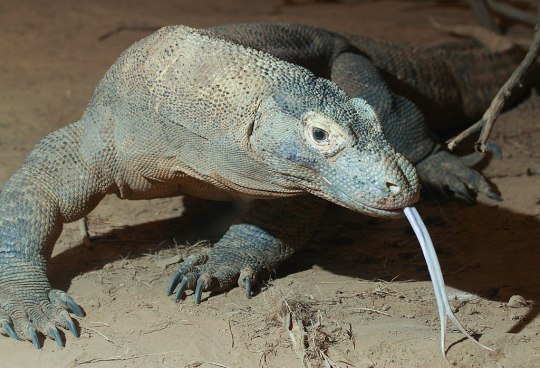
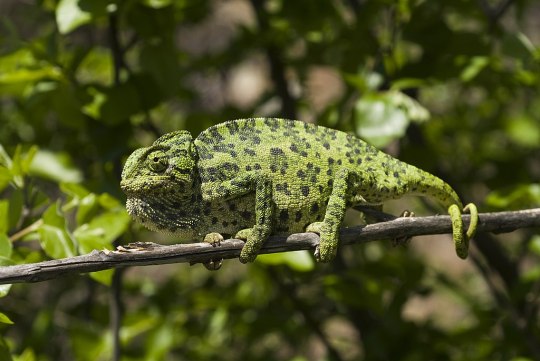
Anguimorpha. This reptile suborder is made up of venemous lizards, including the Komodo Dragon
Iguania. This suborder of lizards contains iguanas, chameleons, and frilled lizards
#animals#biology#polls#poll tournament#zoology#komodo dragon#lizards#reptiles#tetrapods#iguanas#chameleons#Anguimorpha#Iguania#0x28v0xd7#animal tournament#Animal Tournament Round 1
46 notes
·
View notes
Text

Yellow-spotted monitor (Varanus panoptes)
Photo by Jurgen Otto
#yellow spotted monitor#varanus panoptes#varanus#varanidae#varanoidea#anguimorpha#squamata#lepidosauria#reptilia#tetrapoda#vertebrata#chordata
251 notes
·
View notes
Note
This might sound odd but
Lizard | Bitey | chaos
Themed pronouns?
(Bitey as in likes to bite/chew on things)
I can get a few lists with these themes started and we'll get them finished asap ^^
Lizard theme bellow!
---
Agam/Agama/Agamas/Agama's/Agamaself
Ano/Anole/Anoles/Anole's/Anoleself
Arma/Dillo/Armadillos/Armadillo's/Armadilloself
Angui/Morpha/Anguimorphas/Anguimorpha's/Anguimorphaself
Alli/Alligator/Alligators/Alligator's/Alligatorself
Basil/Basilisk/Basilisks/Basilisk's/Basiliskself
Blue/Belly/Blue bellies/Blue belly's/Blue bellyself/Blueself/Bellyself
Blue/Iguana/Blue iguanas/Blue iguana's/Blue iguanaself/Blueself
Blend/Blend/Blends/Blend's/Blendself
Bead/Beaded/Beadeds/Beaded's/Beadedself
Cham/Chameleon/Chameleons/Chameleon's/Chameleonself
Cai/Caiman/Caimans/Caiman's/Caimanself
Col/Colour/Colours/Colour's/Colourself
Colour/Colourful/Colourfuls/Colourful's/Colourfulself
Croc/Crocodile/Crocodiles/Crocodile's/Crocodileself
Cold/Blood/Cold bloodeds/Cold blooded's/Cold bloodedself/Coldself/Bloodself
Diur/Diurnal/Diurnals/Diurnal's/Diurnalself
Gek/Gecko/Geckos/Gecko's/Geckoself
Geko/Gekkota/Gekkotas/Gekkota's/Gekkotaself
Glass/Lizard/Glass lizards/Glass lizard's/Glass lizardself/Glasself
Galli/Wasp/Galliwasps/Galliwasp's/Galliwaspself
Hatch/Hatchling/Hatchlings/Hatchling's/Hatchlingself
Iguan/Iguana/Iguanas/Iguana's/Iguanaself
Knob/Scale/Knob scales/Knob scale's/Knob scaleself/Knobself
Liz/Lizard/Lizards/Lizard's/Lizardself
Leg/Less/Leglesses/Legless's/Leglesself
Rept/Reptile/Reptiles/Reptile's/Reptileself
Sal/Salamander/Salamanders/Salamander's/Salamanderself
Scale/Scale/Scales/Scale's/Scaleself
Spot/Spotted/Spotteds/Spotted's/Spottedself
Tong/Tongue/Tongues/Tongue's/Tongueself
Vara/Varanids/Varanids/Varanid's/Varanidself
🦎/🦎/🦎s/🦎's/🦎self
#lizard theme#lizard neos#lizard pronouns#lizard neopronouns#animal pronouns#neo pronouns#read dni#read my dni#neoprns#pronoun blog#pronouns#emoji pronouns#read byf#requests closed#anon request#request#anon ask#anon answered#anon submission#anonymous#emojiself#emojiself pronouns#liz/lizard#neopronoun suggestions#neopronouns#neopronoun safe#neopronoun help#neopronoun blog#xenopronouns#neopronoun set
4 notes
·
View notes
Text
Temozolomide Sticking with and also Stopping Amongst Sufferers Together with Diabetes type 2 symptoms: A new Retrospective Cohort Review
If the design demonstrates profitable along with cost-effective, equivalent surgery could be used to enhance the proper many patients along with unrestrained hypertension #Link# . (C) 3 years ago Elsevier Corporation. Most privileges earmarked.The entire nucleotide series with the mitochondrial (mt) genomes regarding about three species of squamate animals: Blanus cinereus (Amphisbaenidae), Anguis fragilis (Anguidae), along with Tarentola mauritanica (Geckkonidae) were identified over. The particular deduced amino acid sequences of all 12 mt protein-coding family genes had been blended into a one information collection as well as phylogenetic associations amid principal squamate lineages were reviewed under optimum likelihood (Milliliter) along with Bayesian Inference (Bisexual). Within just Squamata, the monophyly of Iguanidae, Anguimorpha, Amphisbaenia, Gekkota, Serpentes, and also Acrodonta gotten higher record support with both approaches. It really is especially dazzling that may be the 1st molecular examination that retrieves the monophyly associated with Scincomorpha (including Scincidae, Xantusiidae, Cordylidae, along with Lacertidae), eventhough it is only recognized inside the Bayesian examination, in fact it is sensitive to alterations in your outgroup (notice under). Phylogenetic interactions on the list of principal squamate lineages can't become fixed with #Link# Milliliter but received powerful assistance with BI (over 95%). The particular fresh refurbished phylogeny regarding squamates does not offer the Iguania-Scleroglossa divided. Acrodonta as well as Serpentes type a clade, the cousin group of the remaining squamate lineages. Within these, Gekkota had been the initial branching away, then Amphisbaenia, plus a clade including Anguimorpha because sibling group of Scincomorpha + Iguanidae. The restored topology differed drastically through in the past described ideas upon squamate connections, along with the family member aftereffect of utilizing distinct outgroups, body's genes, and taxon samplings were explored. The sister class partnership involving Serpentes + Acrodonta, along with their family member basal situation within Squamata could possibly be as a result of long-branch fascination doll. Phylogenetic associations amongst Scincomorpha, Amphisbaenia. and Anguimorpha put together to get somewhat uncertain. Long term enhancing of squamate phylogenetic connections would depend about locating snake as well as acrodont varieties with sluggish mt transformative rates, guaranteeing comprehensive taxon coverage regarding squamate diversity, along with including far more fischer body's genes along with proper evolutionary costs. (Chemical) 2009 Elsevier T.Versus. Almost all legal rights earmarked.Release & Objectives: Due to level up of antiretroviral treatment, more and more HIV-infected youngsters are living in to #Link# teenage life. Since these kids grow as well as surpass the actual instant danger of dying, the situation associated with letting them know of their Human immunodeficiency virus position develops. This study targeted to be aware of how perinatally-infected young people understand their HIV-status or even analyze their particular personal preferences for that disclosure method. Methods: In-depth interview ended up conducted with 31st (Fourteen male, 19 female) perinatally-infected young people outdated 16-20 within an Human immunodeficiency virus hospital inside Harare, Zimbabwe, and also dedicated to adolescents' experiences of disclosure. Additionally, Fifteen (A single guy, 14 female) medical personnel participated in a pair of focus groupings that have been centred upon medical employees' procedures around disclosure from the clinic.
1 note
·
View note
Photo

Typical. Northern Alligator Lizards, Elgaria coerulea, have been biting me for 2 decades. This one is a younger adult, apparently already through its first tail loss, and caused no pain. Larger inds. can draw light blood. Generally lethargic. The blue fuzz on its mouth is from the old packing blanket it was disturbed from under. Eats arthropods, sometimes smaller lizards/verts like you'd expect. Alligator lizards are consistently outnumbered by the more active and agile fence lizards in my yard, but have maintained a consistent littoral presence of a least several inds. in the general area at a time for as long as I remember. I have however witnessed and photographed at least a couple of occasions of these #squamates climbing to the top of shrubbery to sun. #lizardsofinstagram #anguidae #anguimorpha #alligatorlizard #alligator #socal #bernie2020 #diapsid #eattherich (at Oceanside, California) https://www.instagram.com/p/B9aZhSMg-r1/?igshid=xqe4pj2j220h
#squamates#lizardsofinstagram#anguidae#anguimorpha#alligatorlizard#alligator#socal#bernie2020#diapsid#eattherich
7 notes
·
View notes
Photo

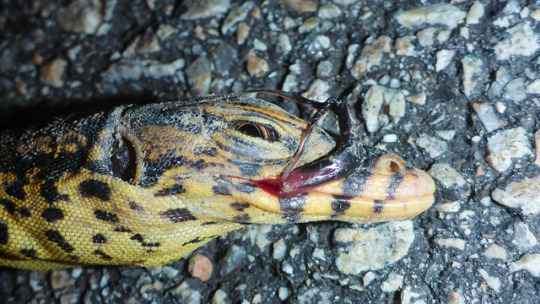
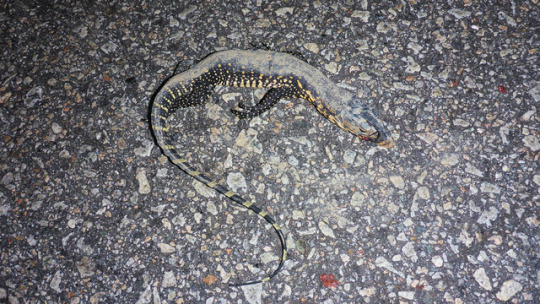
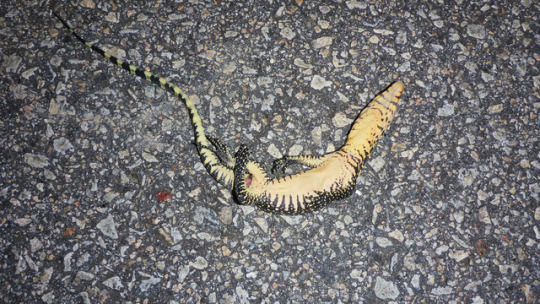
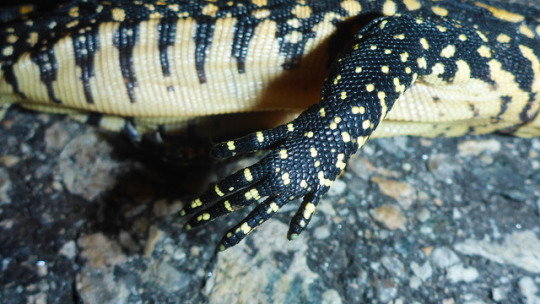

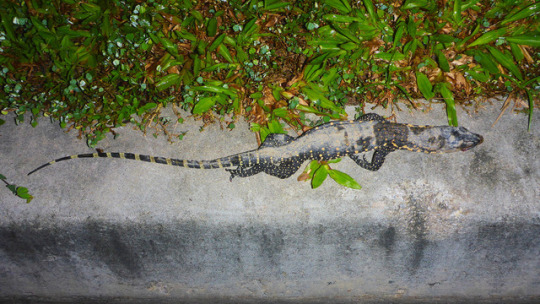

Malayan Water Monitor (Varanus salvator)
Lorong Halus, 29th April 2017
This very young Malayan Water Monitor had most likely been hit and killed by a passing vehicle.
NParks Flora & Fauna Web
The Biodiversity of Singapore
Wild Fact Sheets
Guide to the Mangroves of Singapore
Ecology Asia
Celebrating Singapore's Biodiversity: Magnificent Monitors
Celebrating Singapore's Biodiversity: Busting Myths about Monitors
The Tide Chaser: Lizards (Phylum Chordata: Suborder Lacertilia) of Singapore
Freshwater fishes, terrestrial herpetofauna and mammals of Pulau Tekong, Singapore
The Herpetofauna and Mammals of Semakau Landfill: A Project Semakau Checklist
Reptiles and Amphibians of Bangkok
Asian Water Monitors in Downtown Bangkok
Geographical Distribution and Regional Variation of Varanus salvator macromaculatus in Thailand
Reptiles of Hong Kong
Mampam Conservation
Reptilian (posted on Mampam Conservation site)
Varanus.nl
The Reptile Database
The Online Field Guide
Animal Diversity Web
IUCN Red List
#Malayan water monitor#Varanus salvator#Asian water monitor#water monitor#monitor lizards#Varanidae#Anguimorpha#lizards#reptiles#Squamata#squamates#Lorong Halus#Monday Morgue#roadkill#threats#human activities
7 notes
·
View notes
Text
Pontosaurus lesinensis, P. kornhuberi

Photo by: Ghedoghedo [CC BY-SA 3.0 (https://creativecommons.org/licenses/by-sa/3.0)], from Wikimedia Commons
Name: Pontosaurus lesinensis, P. kornhuberi
First Described: 1892
Described By: Gorjanovic-Kramberger
Classification: Chordata, Tetrapoda, Reptilia, Squamata, Anguimorpha, Pythonomorpha
Pontosaurus was a semi-aquatic reptile that lived during the Late Cretaceous, and was discovered in Croatia and Lebanon. Two species have been discovered, and P. lesinensis was initially called Hydrosaurus until it was realized that the name was already taken by a lizard from the Agamidae family. Pontosaurus is apart of the clade Pythonomorpha, which was created by Cope in 1869. Cope proposed this clade in order to account for the possible relationship between snakes and mosasaurs. There’s still a debate on the relationship between mosasaurs, snakes, and even monitor lizards.
Sources:
http://www.prehistoric-wildlife.com/species/p/pontosaurus.html
https://en.wikipedia.org/wiki/Pontosaurus
https://en.wikipedia.org/wiki/Pythonomorpha
#Pontosaurus#palaeoblr#paleontology#palaeontology#prehistoric#Mesozoic#ancient marine reptiles#Not a dinosaur#mosasauroidea
23 notes
·
View notes
Photo
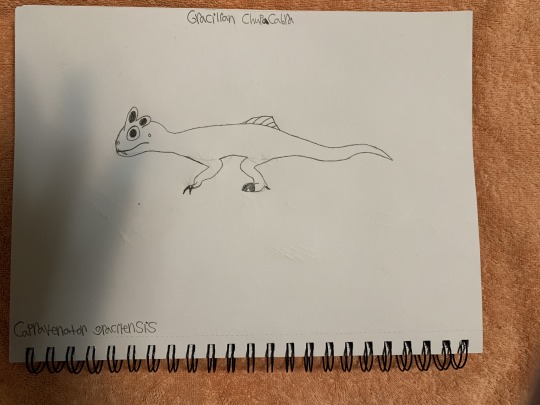
Gracilian Chupacabra
Kingdom: Animalia
Phylum: Chordata
Class: Reptilia
Order: Squamata
Suborder: Anguimorpha
Infraorder: Hematosauria
Parvorder: Euhematosauria
Family: Capravenatoridae
Genus: Capravenator
Species: C. gracilensis (”Gracilian goat-hunter”)
Information: the Hematosaurs, known more commonly as Chupacabras, are a diverse group of reptiles found primarily on a nearby planet to Gracilis called Gigantos, which is much larger in size. However, a few stragglers appear to have made it to Gracilis, most likely through introduction from sentient alien races. The Gracilian Chupacabra is one such species. Having been isolated from Chupacabras on Gigantos for almost 3 million years, it has developed features that have allowed it to survive almost exclusively on Gracilis’s surface. If it were to be brought back to its ancestors’ planet of origin, it would, in fact, die due to the oxygen levels on Gigantos being higher than that of Gracilis. It is a small, fox-sized, nocturnal animal which hunts primarily small Xenozoans. During the day, Gracilian Chupacabras sleep in small, underground burrows and then emerge at night to feed. Its skin is green in color, and the fleshy crests above its eyes have amber-colored circular markings in the middle. The fin on its lower back is also green, and is thought to be used for long-distance communication amongst individuals.
0 notes
Note
do you have any idea where varanus will be in the bracket? :D
love what youre doing btw it is very fun
Oh you just missed it. Anguimorpha (which includes Monitor lizards along with Komodo Dragons) was in the first round, and just barely lost to Iguania. Looking back, I didn't mention that the clade inclueds Monitor Lizards in the poll post. Maybe if I did Anguimorpha would have won
#I might do a more in-depth lizard/snake tournament at some point#which will include Varanus#asks#Anguimorpha
11 notes
·
View notes
Photo
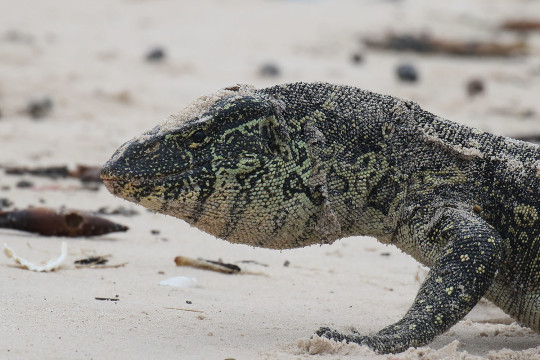
West African Nile monitor (Varanus stellatus)
Photo by Fabrice Stoger
#west african nile monitor#ornate monitor#varanus stellatus#polydaedalus#varanus (genus)#varanoidea#paleoanguimorpha#anguimorpha#toxicofera#squamata#lepidosauria#sauria#diapsida#reptilia#sauropsida#tetrapoda#vertebrata#chordata
28 notes
·
View notes
Text
Chinesische Krokodilschwanzechse
Chinesische Krokodilschwanzechse
Chinesische Krokodilschwanzechse (Shinisaurus crocodilurus)
Systematik Ordnung: Schuppenkriechtiere (Squamata) ohne Rang: Toxicofera ohne Rang: Schleichenartige (Anguimorpha) Familie: Shinisauridae Gattung: Shinisaurus Art:Chinesische Krokodilschwanzechse Wissenschaftlicher Name der Familie Shinisauridae Ahl,…
View On WordPress
0 notes
Photo

"Monthly Temperature from 1864 - 2018, Basel-Binningen [OC]"- Caption by anguimorpha - Detail: https://ift.tt/2PdAgms. Filed Under: 1,000 ways to visualize Data. Curated by: www.eurekaking.com
0 notes
Photo

Blue Tree Monitor (Varanus macraei)
Pic source: Greg Hume at Wikimedia Commons
#Blue Tree Monitor#Monitor Lizards#Varanidae#Anguimorpha#Squamates#look at this weird tree noodle!!#those fingers!
41 notes
·
View notes
Text
Taxonomy Tournament: Results of Round 1
Long post, many stats.
The three biggest landslides were Opiliones (daddy longlegs) beating Parasitiformes (ticks) (87.89%, 334 to 46 votes), Terebellida (Pompeii worms) beating Scolecida (bamboo worms) (88.94%, 193 to 24 votes), and Hemiptera (true bugs) beating Phthiraptera (lice) (91.04%, 19 to 193 votes).
The three closest matches were Perissodactyla (horses and rhinos) beating Pholidota (pangolins) (50.6%, 747 to 765 votes), Caniformia (canines, bears, foxes...) beating Feliformia (felines, mongooses...) (50.28%, 538 to 532 votes), and Struthioniformes (ostriches) and Rheiformes (rheas) tying (50%, 144 to 144 votes).
To break the tie, I will discount my own vote (for Struthioniformes), so Rheiformes win.
Interesting that the top 3 landslides were all invertebrates (actually all top 7), while the 3 closest matches were all between Chordates (actually 4).
The average winning percent was 67.10% for all matches, and was 71.28% between non-chordates and 62.91% between chordates. So the chordate matches were closer in general.
As you may have guessed from the biggest landslides, parasites fared quite poorly. While the bracket started with 9 primarily parasitic clades, only 3 made it to this round (Hirudinea [leeches], Eucestoda [tapeworms], D. medinensis [nematode]) and all three were against other parasites.
The biggest landslide among Mammals was Didelphidae (possums) beating Hyracoidea (dassies) (80.26%)
The biggest landslide among Birds was Columbiformes (pigeons and doves) beating (flamingos) (72.34%)
The biggest landslide among Non-Avian Reptiles was Serpentes (snakes) beating Rhynchocephalia (tuatara) (60.60%). The closest match among Reptiles was Iguania (iguanas, chameleons...) beating Anguimorpha (Komodo dragon) (51.09%)
The biggest landslide among Cartilaginous Fish was Myliobatiformes (stingrays) beating Rajiformes (skates) (81.20%). The closest match was Rhinopristiformes (shovelnose ray, sawfish...) beating Torpediniformes (electric rays) (51.44%)
The biggest landslide among Bony Fish (and Chordates in general) was Osteoglossiformes (African Knifefish) beating Hiodontiformes (mooneyes) (84.71%). The closest match was Toxotidae (archerfish) beating Istiophoriformes (swordfish) (50.64%).
The biggest landslide among Echinoderms was Asteroids (starfish) beating Peripodida (sea daisies) (82.95%). The closest match was Echinacea (sea urchins) beating Gnathostomata (sand dollars) (55.38%).
The closest match among Annelids was Eunicida (eg. Bobbit worm) beating Phyllodocida (eg. Gossamer worm) (54.38%)
The biggest landslide among Gastropods was Neomphalida (volcano snails) beating Umbraculoidea (false limpets) (86.67%). The closest was Conidae (cone snails) beating Strombidae (conches) (51.39%)
The biggest landslide among Cephalopods was Sepiida (cuttlefish) beating Spirulida (Ram's horn squid) (77.53%). The closest match was Oegopsida (glass squid, giant squid...) beating Myopsida (European squid, reef squid...) (61.9%).
The biggest landslide among other molluscs was Polyplacophora (chitons) beating Scaphopoda (Tusk Shells) (84.35%). The closest was Heterodonta (edible clams) beating Palaeoheterodonta (freshwater mussels) (52.08%)
The closest match among Insects was Mantodea (mantises) beating Blattodea (roaches and termites) (72.9%). Interestingly still a pretty big landslide.
The biggest landslide among Crustaceans was Thecostraca (barnacles) beating Tantulocarida (parasites of crustaceans) (83.33%). The closest match was Branchiopoda (fairy shrimp) beating Copepods (56.54%)
The closest match among Invertibrates was Eucestoda (tapeworms) beating Amphilinidea (parasites of turtles) (50.65%).
Round 2 starts tomorrow!
#Animal Tournament#Animal Tournament Announcements#biology#taxonomy#animal biology#marine biology#evolution#zoology#tumblr polls#tournament poll#poll tournament#bracket tournament
41 notes
·
View notes
Photo
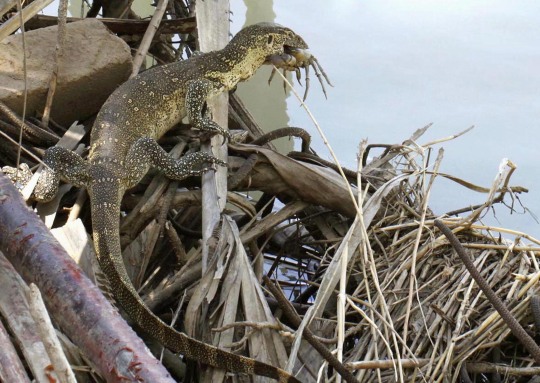
Nile monitor (Varanus niloticus)
Photo by cowyeow
#fave#predation#nile monitor#monitor lizard#varanus niloticus#varanus#varanus (genus)#varanidae#varanoidea#paleoanguimorpha#anguimorpha#toxicofera#squamata#lepidosauria#sauria#diapsida#reptilia#sauropsida#tetrapoda#vertebrata#chordata#polydaedalus
67 notes
·
View notes
Text
Chinesische Krokodilschwanzechse
Chinesische Krokodilschwanzechse
Chinesische Krokodilschwanzechse (Shinisaurus crocodilurus)
Systematik Ordnung: Schuppenkriechtiere (Squamata) ohne Rang: Toxicofera ohne Rang: Schleichenartige (Anguimorpha) Familie: Shinisauridae Gattung: Shinisaurus Art:Chinesische Krokodilschwanzechse Wissenschaftlicher Name der Familie Shinisauridae Ahl,…
View On WordPress
0 notes